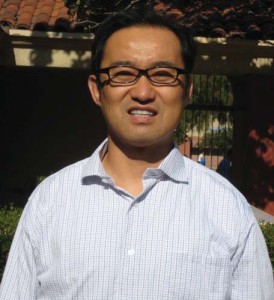by S. Reekie.
We are fortunate to have been one of the few departments permitted to hire a new faculty member last year. I would like to  take this opportunity to introduce to you the new Director of our Graduate Athletic Training Education Program, Dr. Masaaki Tsuruike. Prior to his appointment at SJSU, Dr. Tsuruike was a full-time faculty member at Osaka University of Health and Sport Sciences from 1997 to 2012. Dr. Tsuruike received his BS in Physical Education from Osaka University of Health and Sport Sciences in 1989, his MS in Kinesiology from Indiana University, Bloomington in 1996 and his PhD in 2010 from the same institution where his major area was Human Performance and his minor area was Neuroscience. He was also a visiting scholar there from 2004-2005.
take this opportunity to introduce to you the new Director of our Graduate Athletic Training Education Program, Dr. Masaaki Tsuruike. Prior to his appointment at SJSU, Dr. Tsuruike was a full-time faculty member at Osaka University of Health and Sport Sciences from 1997 to 2012. Dr. Tsuruike received his BS in Physical Education from Osaka University of Health and Sport Sciences in 1989, his MS in Kinesiology from Indiana University, Bloomington in 1996 and his PhD in 2010 from the same institution where his major area was Human Performance and his minor area was Neuroscience. He was also a visiting scholar there from 2004-2005.
Dr. Tsuruike writes: “I remember the University of California, Riverside (UCR) where I first learned English to prepare for graduate school in the United States, now more than 20 years ago, and Del Mar in San Diego where I proposed marriage to my wife in front of the Pacific Ocean view right before sunset almost 10 years ago. My wife, Yasuko, and I really enjoyed the weather, beach, Disneyland, and the entire atmosphere we saw in Southern California. We also learned English and enjoyed cable cars, Fisherman’s Wharf, bay cruises, and Napa Valley in the Bay Area! Yasuko is currently teaching at a public elementary school in Osaka Japan. This year I joined San Jose State University as Graduate Athletic Training Education Program Director, which will be one of the biggest changes in my life and one of my dreams coming true. I look forward to taking part in SJSU Judo. I practiced Judo for 10 years up to the high school level. I’m always excited to watch Judo. Indeed, I practiced Judo with Coach Mike Swain once in Los Angeles while participating in UCR’s Judo club in 1990. I still have the photograph with him.”
Dr. Tsuruike has studied in the field of motor control and is especially interested in the modulation of spinal motoneuron excitability. This modulation, called plasticity, has been shown to be different between older and young populations.